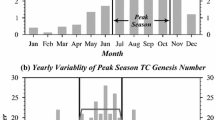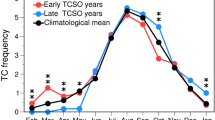Abstract
A prominent meridional oscillation of tropical cyclone (TC) activity in the western North Pacific (WNP) during the past 110 years is identified in this paper. Based on the best-track TC data, the first three Empirical Orthogonal Functions of TC occurrence frequency generally show a northeast-southwest dipole, with the major loadings over the South China Sea (SCS) and the area near Japan. During the periods 1951–1963 and 1997–2019, TC frequency is generally lower over the SCS but higher near Japan. The opposite is true during 1969–1988. Inclusion of the historical TC data from 1910 gives two periods (1943–1963 and 1997–2019) during which the TC numbers near Japan (NJP) are higher but those over the SCS (NSCS) are lower, and two periods (1926–1942 and 1969–1988) with just the opposite pattern. The main factors responsible for this meridional oscillation include changes in the genesis positions of the TCs and their subsequent tracks associated with the interdecadal variation of the large-scale environmental flow patterns. During the periods in which the NSCS (NJP) is higher (lower), the large-scale steering flow is favorable for TCs moving to the SCS. At lower latitudes, vertical wind shear is weaker and low-level cyclonic flow is stronger, which lead to a southward shift of the genesis positions. The patterns are just the reverse during the periods in which the meridional oscillation is in the opposite phase. The oscillation is also found to be partly related to the interdecadal Pacific oscillation through changes in its low-level flow pattern.









Similar content being viewed by others
References
Chan JCL (2000) Tropical cyclone activity over the western North Pacific associated with El Niño and La Niña events. J Clim 13:2960–2972
Chan JCL (2005) Interannual and interdecadal variations of tropical cyclone activity over the western North Pacific. Meteorog Atmos Phys 89:143–152. https://doi.org/10.1007/s00703-005-0126-y
Chin PC (1958) Tropical cyclones in the Western Pacific and China Sea area from 1884 to 1953. Royal Observatory Hong Kong, Hong Kong
Choi KS, Cha YM, Kang SD, Kim HD (2015) Interdecadal variation of TC frequency in Japan. Theor Appl Climatol 121:179–186
Choi KS, Kim BJ, Kim DW, Byun HR (2010) Interdecadal variation of tropical cyclone making landfall over the Korean Peninsula. Int J Climatol 30:1472–1483. https://doi.org/10.1002/joc.1986
Compo GP et al (2011) The twentieth century reanalysis project. Quart J Roy Meteor Soc 137:1–28
Emanuel KA (2010) Tropical cyclone activity downscaled from NOAACIRES reanalysis, 1908-1958. J Adv Model Earth Syst 2:1–12
Gao YX, Zeng YS (1957) Typhoon tracks and statistical analysis. Chinese Science Publications, Beijing, 136pp
Goh AZC, Chan JCL (2010) Interannual and interdecadal variations of tropical cyclone activity in the South China Sea. Int J Climatol 30(6):827–843. https://doi.org/10.1002/joc.1943
Ha Y, Zhong Z (2015) Decadal change of tropical cyclone activity over South China Sea around 2002/2003. J Clim 28(15):5935–5951. https://doi.org/10.1175/JCLI-D-14-00769.1
Henley BJ, Gergis J, Karoly DJ, Power SB, Kennedy J, Folland CK (2015) A tripole index for the interdecadal Pacific oscillation. Clim Dyn 45(11–12):3077–3090. https://doi.org/10.1007/s00382-015-2525-1
Hsu JH, Yao CJ, Wang PY, Yang FS, Shin JL, Hsu SC (1973) Eighty years of typhoon tracks 1892–1977. Central Weather Bureau, Taipei
Kim JH, Ho CH, Sui CH, Park SK (2005) Dipole structure of interannual variations in summertime tropical cyclone activity over East Asia. J Clim 18:5344–5356
Knapp KR, Kruk MC, Levinson DH, Diamond HJ, Neumann CJ (2010) The international best track archive for climate stewardship (IBTrACS). Bull Am Meteorol Soc 91:363–376. https://doi.org/10.1175/2009BAMS2755.1
Kossin JP, Emanuel KA, Camargo SJ (2016) Past and projected changes in western North Pacific tropical cyclone exposure. J Clim 29(16):5725–5739. https://doi.org/10.1175/JCLI-D-16-0076.1
Kossin JP, Emanuel KA, Vecchi GA (2014) The poleward migration of the location of tropical cyclone maximum intensity. Nature 509:349–352. https://doi.org/10.1038/nature13278
Kubota H (2012) Variability of typhoon tracks and genesis over the Western North Pacific. In: Oouchi K, Fudeyasu H (eds) Cyclones: formation, Triggers and Control. Nova Science Publishers, Inc., New York, pp 95–114
Kubota H, Chan JCL (2009) Interdecadal variability of tropical cyclone landfall in the Philippines from 1902 to 2005. Geophys Res Lett 36:L12802. https://doi.org/10.1029/2009GL038108
Li Q, Duan Y (2010) Tropical cyclone strikes at the coastal cities of China from 1949 to 2008. Meteorog Atmos Phys 107:1–7. https://doi.org/10.1007/s00703-010-0065-0
Li RCY, Zhou W (2014) Interdecadal change in South China Sea tropical cyclone frequency in association with zonal sea surface temperature gradient. J Clim 27:5468–5480. https://doi.org/10.1175/JCLI-D-13-00744.1
Liu KS, Chan JCL (2008) Interdecadal variability of western North Pacific tropical cyclone tracks. J Clim 21:4464–4476
Liu KS, Chan JCL (2017) Variations in the power dissipation index in the East Asia region. Clim Dyn 48:1963–1985. https://doi.org/10.1007/s00382-016-3185-5
Matsuura T, Yumoto M, Iizuka S (2003) A mechanism of interdecadal variability of tropical cyclone activity over the western North Pacific. Clim Dyn 21:105–117. https://doi.org/10.1007/s00382-003-0327-3
Park DSR, Ho CH, Kim JH (2014) Growing threat of intense tropical cyclones to East Asia over the period 1977–2010. Environ Res Lett 9:014008. https://doi.org/10.1088/1748-9326/9/1/014008
Rodionov SN (2004) A sequential algorithm for testing climate regime shifts. Geophys Res Lett 31:L09204. https://doi.org/10.1029/2004GL019448
Slivinski LC, Compo GP, Whitaker JS, Sardeshmukh PD, Giese BS, McColl C et al (2019) Towards a more reliable historical reanalysis: improvements for version 3 of the twentieth century reanalysis system. Q J Roy meteor Soc 145:2876–2908. https://doi.org/10.1002/qj.3598
Song J, Klotzbach PJ (2018) What has controlled the poleward migration of annual averaged location of tropical cyclone lifetime maximum intensity over the western North Pacific since 1961? Geophys Res Lett 45:1148–1156. https://doi.org/10.1002/2017GL076883
Sun J, Wang D, Hu X, Ling Z, Wang L (2019) Ongoing poleward migration of tropical cyclone occurrence over the western North Pacific Ocean. Geophys Res Lett 46:9110–9117. https://doi.org/10.1029/2019GL084260
Wadachi (1952) Typhoon tracks 1940–1950. The Central Meteorological Observatory, Tokyo
Wang R, Wu L (2013) Climate changes of Atlantic tropical cyclone formation derived from twentieth-century reanalysis. J Clim 26:8995–9005. https://doi.org/10.1175/JCLI-D-13-00056.1
Yamaguchi M, Maeda S (2020) Increase in the number of tropical cyclones approaching Tokyo since 1980. J Meteor Soc Japan 98:39. https://doi.org/10.2151/jmsj.2020-039
Ying M, Zhang W, Yu H, Lu X, Feng J, Fan Y, Zhu Y, Chen D (2013) An overview of the China Meteorological Administration tropical cyclone database. J Atmos Ocean Technol 31:287–301. https://doi.org/10.1175/JTECH-D-12-00119.1
Zhao H, Wu L (2014) Inter-decadal shift of the prevailing tropical cyclone tracks over the western North Pacific and its mechanism study. Meteorog Atmos Phys 125:89–101. https://doi.org/10.1007/s00703-014-0322-8
Zhao J, Zhan R, Wang Y, Xu H (2018) Contribution of interdecadal Pacific oscillation to the recent abrupt decrease in tropical cyclone genesis frequency over the western North Pacific since 1998. J Clim 31:8211–8224. https://doi.org/10.1175/jcli-d-18-0202.1
Acknowledgements
The authors thank Dr. Mong-Ming Lu of Central Weather Bureau, Prof. Chin-Wen Hung of National Taiwan Normal University, Prof. Chung-Hsiung Sui of National Taiwan University, Mr. Edwin W. L. Ginn of Hong Kong Observatory, Dr. Zhao Bingke of Shanghai Typhoon Institute, and Japan Meteorological Agency for sharing historical tropical cyclone books.
Funding
This project is supported by the Research Grants Council of Hong Kong Grant CityU E-CityU101/16. Hisayuki Kubota is supported by Grant-in-Aid for Scientific Research No. 25282085, No. 15KK0030, No. 2024007, No. 23240122, No. 26220202, No. 18H05307 and No. 19H00562 and Young Scientific Research No. 21684028, which was funded by the Japan Society for the Promotion of Science (JSPS).
Author information
Authors and Affiliations
Corresponding author
Ethics declarations
Conflict of interest
The authors declare no conflict of interest.
Additional information
Publisher’s note
Springer Nature remains neutral with regard to jurisdictional claims in published maps and institutional affiliations.
This article is part of the topical collection on “Historical and recent change in extreme climate over East Asia", edited by Guoyu Ren, Danny Harvey, Johnny Chan, Hisayuki Kubota, Zhongshi Zhang, Jinbao Li
Rights and permissions
About this article
Cite this article
Liu, K.S., Chan, J.C.L. & Kubota, H. Meridional oscillation of tropical cyclone activity in the western North Pacific during the past 110 years. Climatic Change 164, 23 (2021). https://doi.org/10.1007/s10584-021-02983-8
Received:
Accepted:
Published:
DOI: https://doi.org/10.1007/s10584-021-02983-8




